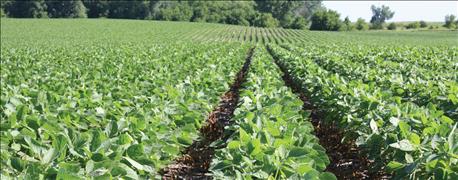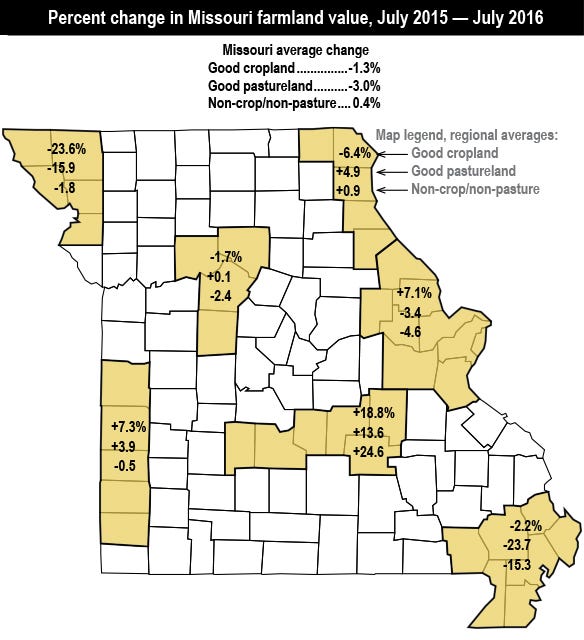
In 2015, the northwest region of Missouri saw a 25% jump in good cropland land values. This year, that number fell by 23%.
"We are not seeing the $8,000 per acre anymore," says Robert Kelly, University of Missouri Extension agriculture business specialist for the northwest region. "We are seeing a lot around $4,000, but there is not a whole lot selling, either."
Kelly says commodity prices and an unstable agriculture economy are factors to the land-value correction in 2016. "It is just not economically feasible to grow crop on high-priced land," he says. "It just doesn't pencil out."
 WHAT LAND WILL BRING: Farmers in Missouri rely on the University of Missouri Extension for information on land values. The 2016 results showed that farmers may be paying less for cropland in 2017.
WHAT LAND WILL BRING: Farmers in Missouri rely on the University of Missouri Extension for information on land values. The 2016 results showed that farmers may be paying less for cropland in 2017.
Many MU Extension offices field questions regarding land values in Missouri. However, the state does not require that land sale prices be reported to any government or public agency. So, the Extension started interviewing lenders, rural appraisers, Extension specialists, real estate agents, farmers and others who would talk about farmland values and trends. They released it in the form of the Missouri Farmland Values Survey, and have been making the results available to producers online since 2000.
The survey found that cropland values were actually up in 10 of the 20 areas into which they've divided the state; however, the statewide average was down 1.3%.

Why the decline?
Comments from respondents in all areas of the state point to low cattle and crop prices for having a negative impact on farmland values. In some areas, 2015 weather created a challenging year, where many farmers had reduced yields resulting in lower income. Reductions in USDA's Conservation Reserve Program enrollment also negatively affected some farm incomes.
Still, some areas saw an increase. According to the report, an influx of Amish and Mennonite buyers was creating demand in the northeast and southern counties. Land near urban or recreational areas also saw increased interest from hobby farm buyers.
Overall, the report points to current economic factors and uncertainty about the future profitability of farm enterprises for slowing the increase in land values this year.

What the report found
Respondents were asked to give estimates of land values for three classes of cropland and pasture (good, average and poor), timberland (with valuable trees), and hunting/recreation land. The survey breaks Missouri into regions and reports averages for each region.
But it was not only cropland that saw a statewide decline in value. Good pastureland was down in 11 areas, with a statewide average decrease of 3%. Timberland was also down by $8/acre. But hunting/recreation land was up on average by $24/acre.

Here is what the survey found on average across the state.
Cropland values per acre:
• Good cropland, $4,677
• Average cropland, $3,669
• Poor cropland, $2,758
Pastureland values per acre:
• Good pastureland, $2,684
• Average pastureland, $2,249
• Poor pastureland, $1,784
Timber and hunting/recreation values per acre:
• Timberland, $1,907
• Hunting/recreation land, $1,807
Who is running the land?
Rada Doty, MU Extension agriculture business specialist and program director for Nodaway County, says that despite land prices and rent suffering in the future, it is farmers who are investing in land. She notes that the owner will farm 75% of the land purchased in northwest Missouri.
Statewide, that numbers drops to 70%. The figure for buyers planning to rent was at 20%, while the number planning to use the land for nonfarm purposes decreased to 10% in 2016.
The complete report can be found online at agebb.missouri.edu/mgt/landsurv/landsurv16.pdf.
About the Author(s)
You May Also Like






